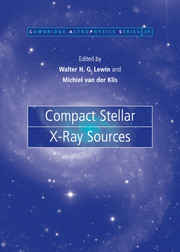Book contents
- Frontmatter
- Contents
- List of contributors
- Preface
- 1 Accreting neutron stars and black holes: a decade of discoveries
- 2 Rapid X-ray variability
- 3 New views of thermonuclear bursts
- 4 Black hole binaries
- 5 Optical, ultraviolet and infrared observations of X-ray binaries
- 6 Fast X-ray transients and X-ray flashes
- 7 Isolated neutron stars
- 8 Globular cluster X-ray sources
- 9 Jets from X-ray binaries
- 10 X-rays from cataclysmic variables
- 11 Super-soft sources
- 12 Compact steller X-ray sources in normal galaxies
- 13 Accretion in compact binaries
- 14 Soft gamma repeaters and anomalous X-ray pulsars: magnetar candidates
- 15 Cosmic gamma-ray bursts, their afterglows, and their host galaxies
- 16 Formation and evolution of compact stellar X-ray sources
- Author index
- Subject index
14 - Soft gamma repeaters and anomalous X-ray pulsars: magnetar candidates
Published online by Cambridge University Press: 01 September 2009
- Frontmatter
- Contents
- List of contributors
- Preface
- 1 Accreting neutron stars and black holes: a decade of discoveries
- 2 Rapid X-ray variability
- 3 New views of thermonuclear bursts
- 4 Black hole binaries
- 5 Optical, ultraviolet and infrared observations of X-ray binaries
- 6 Fast X-ray transients and X-ray flashes
- 7 Isolated neutron stars
- 8 Globular cluster X-ray sources
- 9 Jets from X-ray binaries
- 10 X-rays from cataclysmic variables
- 11 Super-soft sources
- 12 Compact steller X-ray sources in normal galaxies
- 13 Accretion in compact binaries
- 14 Soft gamma repeaters and anomalous X-ray pulsars: magnetar candidates
- 15 Cosmic gamma-ray bursts, their afterglows, and their host galaxies
- 16 Formation and evolution of compact stellar X-ray sources
- Author index
- Subject index
Summary
Introduction
Baade and Zwicky (1934) were the first to envision the formation of neutron stars as the end product of a supernova explosion. Their forward thinking was not vindicated for another three decades, with the discovery of the first radio pulsars by Bell and Hewish (Hewish et al. 1968). What Baade and Zwiscky could not have anticipated, however, was the menagerie of astrophysical objects that are now associated with neutron stars. Today, we observe them as magnetically braking pulsars, accreting pulsars in binary systems, isolated cooling blackbodies, sources of astrophysical jets, and emitters of high-luminosity bursts of X-rays. Here, we focus on two of the most extraordinary evolutionary paths of a neutron star, namely soft gamma repeaters (SGRs) and anomalous X-ray pulsars (AXPs).
Soft gamma repeaters were discovered as high-energy transient burst sources; some were later found also to be persistent X-ray pulsars, with periods of several seconds, that are spinning down rapidly. Anomalous X-ray pulsars are identified through their persistent pulsations and rapid spin down; some have also been found to emit SGR-like bursts. In spite of the differing methods of discovery, this convergence in the observed properties of the SGRs and AXPs has made it clear that they are, fundamentally, the same type of object. What distinguishes them from other neutron stars is the likely source of energy for their radiative emissions, magnetism.
- Type
- Chapter
- Information
- Compact Stellar X-ray Sources , pp. 547 - 586Publisher: Cambridge University PressPrint publication year: 2006
- 277
- Cited by

